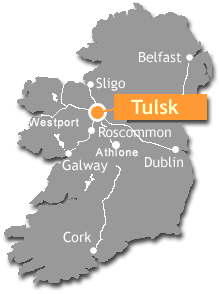
The DP were in residence from May to July this season, for their last year at Tulsk. Archaeological research conducted by the Discovery Programme, Ireland’s archaeological research institute funded by the Heritage Council, has been examining the nature of Gaelic lordship and settlement in north Roscommon during the later medieval period, c. 1170-1650 AD. Since 2003, elements of this work have focussed on the history and development of Tulsk, as the principal residence of the O’Conor Roe lords. Excavation on the ringfort in Tulsk village has revealed a sequence of unexpected and complex settlement horizons, which include a medieval castle-building phase and an Elizabethan-period (c. 1560-90s) occupation, when the mound was included as part of the works associated with the garrisoning of Tulsk by Sir Richard Bingham, ‘flail of Connacht’.
In 2009, the archaeological team has focused on a series of critical strata that explain the dating and development of the site. This year’s work considered the ringfort that underlies the medieval tower.

The work shows the impressive boulder clay bank and ditch. It also shows the levels of soil introduced at a later date to build up the ringfort into a ‘platform’ of ‘raised rath’ form, sometime before the building of the medieval tower. The recent excavation n has also revealed prehistoric levels, that extend back into the Mesolithic period, before the time of farming and when hunting and gathering prevailed. The sequence of levels reveals the degree to which the medieval lords attached value to returning to known sites of habitation.
Student volunteers from Ireland and from around the world have contributed to the success of the excavation project, and publications are expected to begin next year.

 Ducks on Bridge at Cruachan Ai Heritage Center, County Roscommon, Ireland
Ducks on Bridge at Cruachan Ai Heritage Center, County Roscommon, Ireland

 "Rathcroghan: Archaeological and geophysical survey in a Ritual Landscape"
"Rathcroghan: Archaeological and geophysical survey in a Ritual Landscape" Professor John Waddell, Opening Speech at the Launch of Rathcroghan Book
Professor John Waddell, Opening Speech at the Launch of Rathcroghan Book



